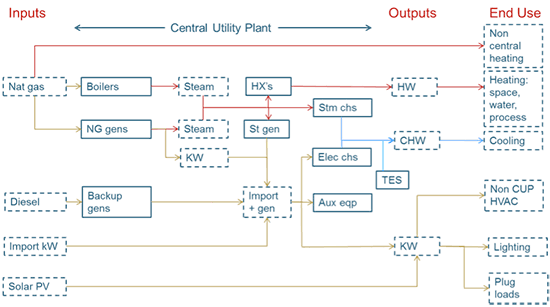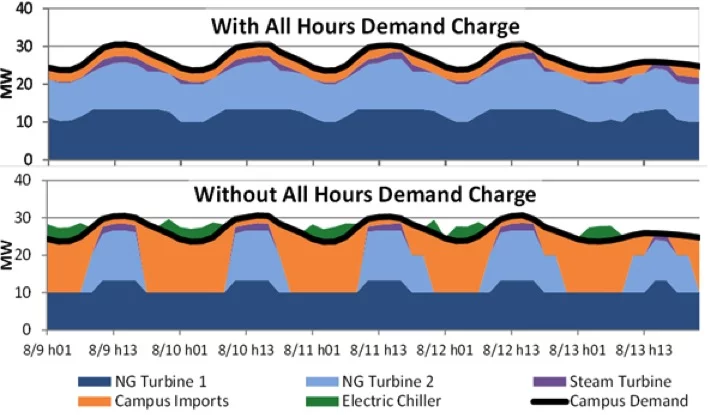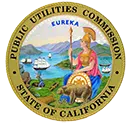
Such microgrids may supplement purchase of electricity from the utility with local resources for generating and managing energy, such as solar photovoltaics, natural gas fired combined heat and power (CHP), efficient cooling systems, energy storage, and programs to reduce or time-shift demand. Energy and Environmental Economics (E3) Consulting used Analytica to create a dispatch optimization tool for the University of California’s San Diego’s (UCSD) microgrid.
With support from the California Solar Initiative RD&D program, E3 explored how UCSD microgrid resources could be used to support utility grid operations and integrate higher penetrations of PV generation.
The challenge
UCSD’s Campus Utility Plant (CUP) generates 88% of the university’s electricity while saving $8 Million dollars annually on utility bills.
UCSD’s clean energy initiative aims to increase solar generation, conserve energy and reduce its carbon footprint in line with California’s ambitious goals to reduce GHG emissions. UCSD’s resources energy flow diagram can be seen in the figure below.

UCSD’s current microgrid includes a 30 Megawatt (MW) natural gas combined heat and power (CHP) plant, 1.5 MW solar photovoltaic (PV) panels, 2.8 MW fuel cell, and a 300 kW water heater.
It stores water chilled at night using off-peak electricity in a 3.8 million gallon water tank to provide cooling during the day when the power load and cost of electricity is higher.
A smart microgrid system manages this entire electricity, heating, and cooling demand and supply. This flagship project illustrates how a large organization can be nearly self-reliant in meeting its energy needs.
Today California gets 20% of its electricity from renewables, well on the way to its ambitious 2020 target of 33% renewables to reduce GHG emissions. Increasing generation from wind and Solar PV, with their intermittent, uncontrollable production creates a big challenge for smooth grid integration.
This requires greater flexibility from other sources, including energy storage, peak shifting, and demand management, especially by large consumers, like UCSD. Questions that arise here include:
- How much could UCSD reduce emissions by expanding its PV generation?
- Would an expanded microgrid be cost-effective and add grid flexibility with current tariffs and incentives?
- If not, how should tariffs or other policies be changed to encourage large utility customers like UCSD expand flexibility in ways that are also beneficial to the grid as a whole?
Why Analytica?
UCSD’s microgrid collects real-time data of load generation, price performance and weather data from a myriad of disparate sources. It attempts to optimize local generation, and energy storage, along with purchase or sale of energy to the utility.
It is challenging to aggregate data from numerous sources in a consistent format in order to analyze the economic effects of changes to the system, such as increased PV generation, shape of demand curves, and increased demand-response.
Analytica’s transparent yet powerful platform, optimization engine and easily extensible arrays could incorporate a wide variety of data sources from distributed energy resource technologies that less flexible models could not.
The solution
E3 used Analytica to develop an engineering and economic Dispatch Optimization Tool of UCSD’s microgrid to:
- Model thermal and electrical systems of the central plant,
- Determine hourly dispatch of power generation and thermal storage to minimize total costs, subject to operating constraints of equipment.
E3 used the model to test the operational and economic viability of integrating additional PV into the grid, with three dispatch strategies:
- Peak or Permanent load shifting (PLS): Moves load from peak periods to off-peak periods reducing the service cost to utilities and to customers as well.
- PV Firming Strategies: Required by utilities to counterbalance error between the day ahead forecasts and actual generation from solar PV.
- Grid Support: Support by UCSD (load based) resources to help the grid operations by bidding flexible load.
The model compared these three strategies in terms of variableenergy, costs and benefits against UCSD’s status quo system. In some cases, the dispatch strategies were technically feasible and cost-effective in terms of total resource costs, but not economic from UCSD’s perspective as a utility customer.
In these cases, E3 identified what tariff and regulatory changes would motivate UCSD (and similar large commercial and industrial customers) to adopt such strategies that would be cost-effective for the grid as a whole.
For example, removing demand charge from off-peak hours, can encourage import of grid power during those hours to chill water for later use at peak hours, to the benefit of the utility. This can be seen in the Modeled Optimal Dispatch figure below

Conclusions
Adding substantial solar PV to UCSD’s micro grid is technically feasible and could be cost-effective.
New products, tariff structures and policies will be required to incentivize large utility customers to increase adoption of renewables and for this demand side resources to provide greater flexibility to the grid. A few observations of this study are:
- Removal of all-hours demand charge will make it cost effective for large customers to shift peak load.
- As more resources become available to provide flexibility, the cost effectiveness of relying on on-site resources for PV firming will improve. However, at the present tariff point, it is cost advantageous for UCSD to rely on the grid rather than campus resources for PV firming.
- Supplemental tariffs and incentives, layered on top of retail rates will be necessary to engage the full potential of DER’s for renewable integration.
Authors



Energy and Environmental Economics Consulting (E3)
Clients



For more
For this project, Energy and Environmental Economics Consulting Inc. (E3) received funding through the California Solar Initiative (CSI) Research, Development, Demonstration and Deployment Program Grant, supported by California Public Utilities Commission (CPUC).
Itron Inc, and Pacific Gas & Electric (PG&E) provided grant management support and contract management to E3.
UC San Diego’s website has details on its energy program and about its microgrid
Strategies and Incentives for Integration of Renewable Generation Using Distributed Energy Resources: A Case Study based on the University of California, San Diego, A California Solar Initiative (CSI) Research, Development, Demonstration, and Deployment Program Grant, Task 6-8 Interim Report, July 17, Energy and Environmental Economics Inc. Viridity Energy Inc., E3’s website.
Highlights of the report can be found in the paper: Sreedharan, Farbes, Cutter, Delivering Renewable Integration Services Through University Microgrid Generations: A University of California, San Diego Microgrid Case Study, Proceedings of the 8th International Conference on Energy Sustainability & 12th Fuel Cell Science, Engineering and Technology Conference ESFuelCell 2014.




